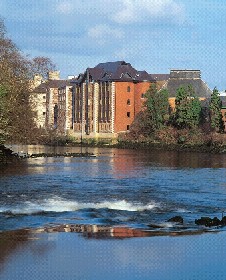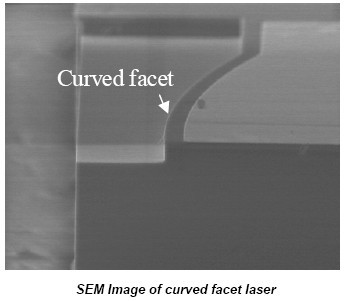

World Wide Welfare:
high BRIGHTness
semiconductor lasER for
gEneric Use
high BRIGHTness
semiconductor lasER for
gEneric Use
Partner 22- Tyndall National Institute, Ireland
The Tyndall National Institute was established in 2004 as an amalgamation of NMRC with other Information and Communication Technologies (ICT) based scientific activities in the Cork region. The Institute is named after the Irish polymath John Tyndall (1820-1893) who invented the light pipe, developed spectroscopy, sterilisation processes and studied the atmosphere and the ozone layer.
There are 300 researchers at Tyndall with core competencies in Photonics, Nanotechnologies, Micro-technologies and ICT-Bio technologies.
The fundamental mission of Tyndall is to develop new scientific knowledge and key technological capabilities in strategic ICT-related fields to successfully fuel the evolution of the core technology platforms that will in turn enable Irish and European industry to develop next-generation products and applications.
Tyndall (via NMRC) has a 20-year history of participation in advanced European Research activities and is today a key European Research hub.
The Photonics activities at Tyndall encompass basic physics to communication systems with research teams working in quantum optics, theory, nanostructures, non-linear dynamics, sources and photonic systems. Currently Tyndall houses 6000m2 of state-of-the-art laboratory space including device fabrication facilities in III-V and silicon materials. A major expansion of these facilities in underway.
- The photonic sources group (http://www.tyndall.ie/research/photonics-sources-group/index.html) are investigating materials based on quantum wells and dots from the UV to the IR with resultant devices fro applications as: High power lasers
- Telecommunication lasers
- VCSELs
- GaN devices
Achievements include watt level diffraction limited power from curved facet lasers; a patented approach to low-cost, single frequency lasers, red-emitting VCSELs with high single mode power and temperature stability and high extraction efficiency LEDs based on GaN. A number of spin-out companies have been established as a result of the photonic activities
There are 300 researchers at Tyndall with core competencies in Photonics, Nanotechnologies, Micro-technologies and ICT-Bio technologies.
The fundamental mission of Tyndall is to develop new scientific knowledge and key technological capabilities in strategic ICT-related fields to successfully fuel the evolution of the core technology platforms that will in turn enable Irish and European industry to develop next-generation products and applications.
Tyndall (via NMRC) has a 20-year history of participation in advanced European Research activities and is today a key European Research hub.
The Photonics activities at Tyndall encompass basic physics to communication systems with research teams working in quantum optics, theory, nanostructures, non-linear dynamics, sources and photonic systems. Currently Tyndall houses 6000m2 of state-of-the-art laboratory space including device fabrication facilities in III-V and silicon materials. A major expansion of these facilities in underway.
- The photonic sources group (http://www.tyndall.ie/research/photonics-sources-group/index.html) are investigating materials based on quantum wells and dots from the UV to the IR with resultant devices fro applications as: High power lasers
- Telecommunication lasers
- VCSELs
- GaN devices
Achievements include watt level diffraction limited power from curved facet lasers; a patented approach to low-cost, single frequency lasers, red-emitting VCSELs with high single mode power and temperature stability and high extraction efficiency LEDs based on GaN. A number of spin-out companies have been established as a result of the photonic activities
Activities in WWW.BRIGHT-EU
The highest quality semiconductor laser beams are obtained with tightly confined waveguides resulting in limited output power and large beam divergences compromising the ability to use these beams.
To address these issues, we are developing approaches for the transverse and lateral modes using quantum dot active regions (UWUERZ) which are based on engineering large mode size lasers and using curved facet unstable resonators to improve lateral beam coherence. The objectives are to scale these devices into the watt level.
We are also developing efficient models for gain and spontaneous recombination and carrier capture in short-wavelength quantum well active regions.
This information is being informed by detailed measurements of the characteristics of quantum well structures grown at our partners in OSRAM and FBH.
For further information, please contact: Brian Corbett (Brian.Corbett@tyndall.ie, Tel: +353 21 4904380)
The highest quality semiconductor laser beams are obtained with tightly confined waveguides resulting in limited output power and large beam divergences compromising the ability to use these beams.
To address these issues, we are developing approaches for the transverse and lateral modes using quantum dot active regions (UWUERZ) which are based on engineering large mode size lasers and using curved facet unstable resonators to improve lateral beam coherence. The objectives are to scale these devices into the watt level.
We are also developing efficient models for gain and spontaneous recombination and carrier capture in short-wavelength quantum well active regions.
This information is being informed by detailed measurements of the characteristics of quantum well structures grown at our partners in OSRAM and FBH.
For further information, please contact: Brian Corbett (Brian.Corbett@tyndall.ie, Tel: +353 21 4904380)


[Home] [Project] [Participants] [Newsletters] [Publications] [Workshops] [Tutorials] [More...] [Private] [Legal notice]
